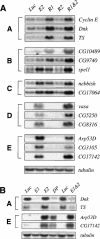Cell cycle-dependent and cell cycle-independent control of transcription by the Drosophila E2F/RB pathway
- PMID: 12975318
- PMCID: PMC196467
- DOI: 10.1101/gad.1116703
Cell cycle-dependent and cell cycle-independent control of transcription by the Drosophila E2F/RB pathway
Abstract
To determine which E2F/RB-family members are functionally important at E2F-dependent promoters, we used RNA interference (RNAi) to selectively remove each component of the dE2F/dDP/RBF pathway, and we examined the genome-wide changes in gene expression that occur when each element is missing. The results reveal a remarkable division of labor between family members. Classic E2F targets, encoding functions needed for cell cycle progression, are expressed in cycling cells and are primarily dependent on dE2F1and RBF1 for regulation. Unexpectedly, there is a second program of dE2F/RBF-dependent transcription, in which dE2F2/RBF1or dE2F2/RBF2 complexes repress gene expression in actively proliferating cells. These new E2F target genes encode differentiation factors that are transcribed in developmentally regulated and gender-specific patterns and not in a cell cycle-regulated manner. We propose that dE2F/RBF complexes should not be viewed simply as a cell cycle regulator of transcription. Instead, dE2F/RBF-mediated repression is exerted on genes that encode an assortment of cellular functions, and these effects are reversed on sets of functionally related genes in particular developmental contexts. As a result, dE2F/RBF regulation is used to link gene expression with cell cycle progression at some targets while simultaneously providing stable repression at others.
Figures







References
-
- Burke T., Waring, G.L., Popodi, E., and Minoo, P. 1987. Characterization and sequence of follicle cell genes selectively expressed during vitelline membrane formation in Drosophila. Dev. Biol. 124: 441-450. - PubMed
-
- Cam H. and Dynlacht, B.D. 2003. Emerging roles for E2F: Beyond the G1/S transition and DNA replication. Cancer Cell 3: 311-316. - PubMed
-
- Cayirlioglu P., Bonnette, P.C., Dickson, M.R., and Duronio, R.J. 2001. Drosophila E2f2 promotes the conversion from genomic DNA replication to gene amplification in ovarian follicle cells. Development 128: 5085-5098. - PubMed
Publication types
MeSH terms
Substances
Grants and funding
LinkOut - more resources
Full Text Sources
Molecular Biology Databases
Research Materials
